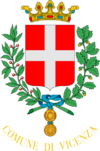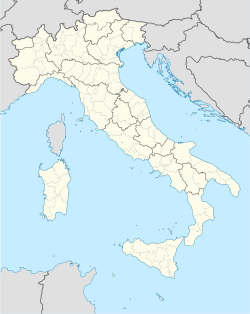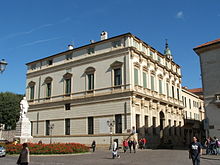Vicenza
| This article needs additional citations for verification. (March 2011) |
| Vicenza | ||
|---|---|---|
| Comune | ||
| Città di Vicenza | ||
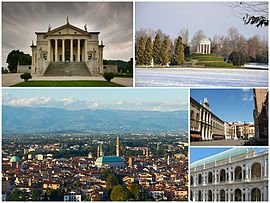
A collage of Vicenza showing: the Villa Capra "La Rotonda", the
classical temple in the Parco Querini, a panorama of the city from the Monte Berico, the Piazza dei Signori and the Renaissance Basilica Palladiana.
|
||
|
||
| Location of Vicenza in Italy | ||
| Coordinates: 45°33′N 11°33′E / 45.550°N 11.550°ECoordinates: 45°33′N 11°33′E / 45.550°N 11.550°E | ||
| Country | Italy | |
| Region | Veneto | |
| Province | Provincia di Vicenza | |
| Government | ||
| • Mayor | Achille Variati (PD) | |
| Area | ||
| • Total | 80 km2 (30 sq mi) | |
| Elevation | 39 m (128 ft) | |
| Population (January 1, 2014)[1] | ||
| • Total | 113,655 | |
| • Density | 1,400/km2 (3,700/sq mi) | |
| Demonym | Vicentini | |
| Time zone | CET (UTC+1) | |
| • Summer (DST) | CEST (UTC+2) | |
| Postal code | 36100 | |
| Dialing code | 0444 | |
| Patron saint | Madonna of Monte Berico | |
| Saint day | September 8 | |
| Website | Official website | |
| Town of Vicenza and the Palladian Villas of the Veneto | |
|---|---|
| Name as inscribed on the World Heritage List | |
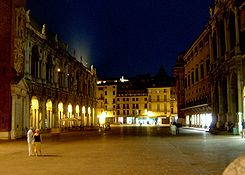 |
|
| Type | Cultural |
| Criteria | i, ii |
| Reference | 712 |
| UNESCO region | Europe and North America |
| Inscription history | |
| Inscription | 1994 (18th Session) |
| Extensions | 1996 |
Vicenza [viˈtʃɛntsa] ![]() listen (help·info) (Venetian: Vicensa) is a city in northeastern Italy. It is in the Veneto region at the northern base of the Monte Berico, where it straddles the Bacchiglione River. Vicenza is approximately 60 kilometres (37 mi) west of Venice and 200 kilometres (120 mi) east of Milan.
listen (help·info) (Venetian: Vicensa) is a city in northeastern Italy. It is in the Veneto region at the northern base of the Monte Berico, where it straddles the Bacchiglione River. Vicenza is approximately 60 kilometres (37 mi) west of Venice and 200 kilometres (120 mi) east of Milan.
Vicenza is a thriving and cosmopolitan city, with a rich history and culture, and many museums, art galleries, piazzas, villas, churches and elegant Renaissance palazzi. With the Palladian Villas of the Veneto in the surrounding area, and his renowned Teatro Olimpico (Olympic Theatre), the "city of Palladio" has been enlisted as UNESCO World Heritage Site since 1994.[2]
In December 2008, Vicenza had an estimated population of 115,927,[3] and a metropolitan area of 270 000. Vicenza is the third-largest Italian industrial centre as measured by the value of its exports, and is one of the country's wealthiest cities,[2][4] in large part due to its textile and steel industries, which employ tens of thousands. Additionally, about one fifth of the country's gold and jewelry is made in Vicenza, greatly contributing to the city's economy. Another important sector is the engineering/computer components industry (Federico Faggin, the microprocessor's co-inventor, was born in Vicenza).[5]
Contents
[hide]History[edit]
Roman age[edit]
Vicentia was settled by the Italic Euganei tribe and then by the Paleo-Veneti tribe in the 3rd and 2nd centuries BC.[6] The Romans allied themselves with the Paleo-Veneti in their fight against the Celtic tribes that populated north-western Italy.[citation needed] The Roman presence in the area grew exponentially[citation needed] over time and the Paleo-Veneti (whose culture mirrored Etruscan and Greek values more so than Celtic ones) were gradually assimilated.[citation needed] In 157 BC, the city was a de facto Roman centre and was given the name of Vicetia or Vincentia, meaning "victorious".
The population of Vicentia received Roman citizenship in 49 BC. The city had some importance as a way-station on the important road from Mediolanum (Milan) to Aquileia, near Tergeste (Trieste), but it was overshadowed by its neighbor Patavium (Padua). Little survives of the Roman city, but three of the bridges across the Bacchiglione and Retrone rivers are of Roman origin, and isolated arches of a Roman aqueduct exist outside the Porta Santa Croce.
During the decline of the Western Roman Empire, Heruls, Vandals, Alaric and his Visigoths, as well as the Huns laid waste to the area, but the city recovered after the Ostrogoth conquest in 489 AD, before passing to Byzantine rule soon after. It was also an important Lombard city and then a Frankish centre. Numerous Benedictine monasteries were built in the Vicenza area, beginning in the 6th century.
Middle Ages[edit]
In 899, Vicenza was destroyed by Magyar raiders.
In 1001, Otto III handed over the government of the city to the bishop, and its communal organization had an opportunity to develop, separating soon from the episcopal authority. It took an active part in the League with Verona and, most of all, in the Lombard League (1164–1167) against Emperor Frederick I Barbarossa compelling Padua and Treviso to join: its podestà, Ezzelino II il Balbo, was captain of the league. When peace was restored, however, the old rivalry with Padua, Bassano, and other cities was renewed, besides which there were the internal factions of the Vivaresi (Ghibellines) and the Maltraversi (Guelphs).
The tyrannical Ezzelino III from Bassano drove the Guelphs out of Vicenza, and caused his brother, Alberico, to be elected podestà (1230). The independent commune joined the Second Lombard League against Emperor Frederick II, and was sacked by that monarch (1237), after which it was annexed to Ezzelino's dominions. On his death the old oligarchic republic political structure was restored -a consiglio maggiore ("grand council") of four hundred members and a consiglio minore ("small council") of forty members - and it formed a league with Padua, Treviso and Verona. Three years later the Vicentines entrusted the protection of the city to Padua, so as to safeguard republican liberty; but this protectorate (custodia) quickly became dominion, and for that reason Vicenza in 1311 submitted to the Scaligeri lords of Verona, who fortified it against the Visconti of Milan.
Vicenza came under rule of Venice in 1404, and its subsequent history is that of Venice. It was besieged by the Emperor Sigismund, and Maximilian I held possession of it in 1509 and 1516.
Modern age[edit]
Vicenza was a candidate to host the Council of Trent.
The 16th century was the time of Andrea Palladio, who left many outstanding examples of his art with palaces and villas in the city's territory, which before Palladio's passage, was arguably the most downtrodden and esthetically lacking city of the Veneto.
After 1797, under Napoleonic rule, it was made a duché grand-fief (not a grand duchy, but a hereditary (extinguished in 1896), nominal duchy, a rare honor reserved for French officials) within Napoleon's personal Kingdom of Italy for general Caulaincourt, also imperial Grand-Écuyer.
After 1814, Vicenza passed to the Austrian Empire. In 1848, however, the populace rose against Austria, more violently then in any other Italian centre apart from Milan and Brescia (the city would receive the highest award for military valour for the courage displayed by revolutionaries in this period). As a part of the Kingdom of Lombardy-Venetia, it was annexed to Italy after the 3rd war of Italian independence.
Vicenza's area was a location of major combat in both World War I (on the Asiago plateau) and World War II (a focal centre of the Italian resistance), and it was the most damaged city in Veneto by Allied bombings, including many of its monuments; the civil victims were over 2,000. After the end of the latter, what followed was a period of depression following the devasatation caused by two world conflicts. In the 1960s the whole central part of Veneto, witnessed a strong economic development caused by the emergence of small and medium family businesses, ranging in a vast array of products (that often emerged illegally) that paved the way for what would be known as the "miracolo del Nord-est" (Miracle of the North-east). In the following years, the economic development grew vertiginously. Huge industrial areas sprouted around the city, massive and disorganised urbanisation and employment of foreign immigrants increased.
Vicenza is home to the United States Army post Caserma Ederle (Camp Ederle), also known as the U.S. Army Garrison Vicenza. In 1965, Caserma Ederle became the headquarters for the Southern European Task Force, which includes the 173d Airborne Brigade. In January 2006, the European Gendarmerie Force was inaugurated in Vicenza.
Climate[edit]
| [hide][hide][hide][hide]Climate data for Vicenza (1971–2000, extremes 1951–2008) | |||||||||||||
|---|---|---|---|---|---|---|---|---|---|---|---|---|---|
| Month | Jan | Feb | Mar | Apr | May | Jun | Jul | Aug | Sep | Oct | Nov | Dec | Year |
| Record high °C (°F) | 15.9 (60.6) |
21.7 (71.1) |
26.8 (80.2) |
30.0 (86) |
34.8 (94.6) |
37.4 (99.3) |
37.4 (99.3) |
38.2 (100.8) |
33.2 (91.8) |
29.4 (84.9) |
24.4 (75.9) |
17.8 (64) |
38.2 (100.8) |
| Average high °C (°F) | 7.0 (44.6) |
9.3 (48.7) |
13.5 (56.3) |
17.3 (63.1) |
22.8 (73) |
26.2 (79.2) |
29.1 (84.4) |
28.7 (83.7) |
24.3 (75.7) |
18.4 (65.1) |
11.8 (53.2) |
7.5 (45.5) |
18.0 (64.4) |
| Daily mean °C (°F) | 3.0 (37.4) |
4.6 (40.3) |
8.4 (47.1) |
12.1 (53.8) |
17.4 (63.3) |
20.8 (69.4) |
23.4 (74.1) |
22.9 (73.2) |
18.9 (66) |
13.5 (56.3) |
7.5 (45.5) |
3.5 (38.3) |
13.0 (55.4) |
| Average low °C (°F) | −1.0 (30.2) |
−0.1 (31.8) |
3.3 (37.9) |
7.0 (44.6) |
11.9 (53.4) |
15.5 (59.9) |
17.7 (63.9) |
17.2 (63) |
13.5 (56.3) |
8.5 (47.3) |
3.1 (37.6) |
−0.4 (31.3) |
8.0 (46.4) |
| Record low °C (°F) | −20.0 (−4) |
−18.6 (−1.5) |
−10.0 (14) |
−3.2 (26.2) |
−0.8 (30.6) |
2.6 (36.7) |
9.5 (49.1) |
8.0 (46.4) |
3.8 (38.8) |
−3.6 (25.5) |
−8.0 (17.6) |
−13.0 (8.6) |
−20.0 (−4) |
| Average precipitation mm (inches) | 76.5 (3.012) |
67.9 (2.673) |
76.9 (3.028) |
97.3 (3.831) |
100.0 (3.937) |
104.3 (4.106) |
74.0 (2.913) |
79.5 (3.13) |
92.7 (3.65) |
115.5 (4.547) |
93.7 (3.689) |
81.5 (3.209) |
1,059.8 (41.725) |
| Avg. precipitation days (≥ 1.0 mm) | 7.0 | 5.0 | 6.4 | 9.5 | 10.0 | 9.3 | 6.8 | 6.7 | 6.1 | 7.5 | 7.1 | 6.4 | 87.8 |
| Avg. relative humidity (%) | 81 | 77 | 73 | 74 | 72 | 73 | 72 | 73 | 74 | 78 | 80 | 82 | 76 |
| Source: Servizio Meteorologico (humidity 1961–1990)[7][8][9] | |||||||||||||
Economy[edit]
The surrounding country is predominantly agricultural. Major products are wine, wheat, corn, olive oil ( in the Barbarano area ) and cherries and asparagus are a particularity of Bassano. There are also quarries of marble, sulphur, copper, and silver mines, and beds of lignite and kaolin; mineral springs also abound, the most famous being those of Recoaro. Massive industrial areas surround the city and extend extensively in the western and eastern hinterland, with numerous steel and textile factories located in the Montecchio Maggiore, Chiampo and Sovizzo area in the west and Camisano Vicentino and Torri di Quartesolo in the east, areas characterised by a disorganised and extensive cementifaction. Elitè sectors are the jewelry and clothing factories. Important vicentino clothing firms include: Diesel, Pal Zileri, Marzotto, Bottega Veneta, Marlboro Classics etc. The Gold Exposition is world-famous and it takes place in Vicenza three times per year (January, May, September). Other industries worthy of mention are the woollen and silk, pottery, and musical instruments. The headquarters of the bicycle component manufacturer Campagnolo and the protective wear for sports manufacturer Dainese are located here.
Demographics[edit]
In 2007, there were 114,268 people residing in Vicenza, located in the province of Vicenza, Veneto, of whom 47.6% were male and 52.4% were female. Minors (children ages 18 and younger) totalled 17.17 percent of the population compared to pensioners who number 21.60 percent. This compares with the Italian average of 18.06 percent (minors) and 19.94 percent (pensioners). The average age of Vicenza residents is 43 compared to the Italian average of 42. In the five years between 2002 and 2007, the population of Vicenza grew by 3.72 percent, while Italy as a whole grew by 3.85 percent.[10] The current birth rate of Vicenza is 9.16 births per 1,000 inhabitants compared to the Italian average of 9.45 births.
| This article needs additional citations for verification. (April 2014) |
In 2010, 83.5% of the population was Italian. From 1876 to 1976 it has been calculated that over a million people from the province of Vicenza have emigrated, with more than 3 million people of vicentino descent living around the world (most common migrational currents included Brasil, United States of America, Canada, Australia, Germany, France, Belgium and Switzerland) escaping the devastation left by poverty, war and sickness. Today nearly 100,000 Vicenza citizens live and work abroad. Today the city has morphed from land of emigration to immigration. The largest immigrant group comes from other European nations (the largest being Serbia, Romania, and Moldova), South Asian (the largest being Bangladesh and Pakistan), sub-saharan Africa, and North Africa (largest is from Morocco). The city is predominantly Roman Catholic, but due to immigration now has some Orthodox Christian, Muslim and Sikh followers.
Main sights[edit]

In 1994 UNESCO inscribed "Vicenza, City of Palladio" on its list of World Heritage Sites. In 1996 the site was expanded to include the Palladian villas outside the core area, and accordingly renamed "City of Palladio and the Palladian Villas of the Veneto".
Palladio's works[edit]
Vicenza is home to twenty-three buildings designed by Palladio. The famous ones include:
- Villa Almerico Capra (also known as "La Rotonda"), located just outside the downtown area;
- Basilica Palladiana, centrally located in Vicenza's Piazza dei Signori, of which Palladio himself said that it might stand comparison with any similar work of antiquity;
- Teatro Olimpico, designed for the Accademia Olimpica and begun to be built in 1580, when Palladio died. The wooden scenes are by Vincenzo Scamozzi;
- Palazzo Chiericati, home of the Town pinacotheca;
- Palazzo Barbaran da Porto, home of the Museo Palladio;
- Palazzo del Capitaniato, home of the Town council;
- Palazzo Porto;
- Palazzo Porto in Piazza Castello (unfinished);
- Palazzo Thiene Bonin Longare (built by Vincenzo Scamozzi);
- Palazzo Thiene;
- Villa Gazzotti Grimani, in the frazione Bertesina.
Other sights[edit]
Churches[edit]
Some of the main historical churches:
- The Cathedral of Vicenza (church of Santa Maria Annunciata), dating from early in the 11th century, and restored in the 13th, 16th, 19th and after the ruinous destruction of World War II, possesses a number of paintings and sculptures, nearly all of them by Vicentine artists; the dome and north side door were designed by Andrea Palladio.
- Basilica Sanctuary of St. Mary of Monte Berico. Carried out in two stages, first in 1428, then finished in 1703 by Carlo Borella, it includes two churches from two different periods: the first in Gothic style, the second a classic and baroque style basilica. In the adjacent convent the big painting of The Supper of Saint Gregory the Great by Paolo Veronese. The bell tower (1826) was designed by Antonio Piovene. The building commemorates the two apparitions of Our Lady to a pious woman of Vicenza, Vincenza Pasini, who lived in a village in the province, and the liberation of the city from a terrible plague.
- Basilica of Santi Felice and Fortunato, built in the 4th century within a Roman cemetery and majestically expanded in the 5th century to house the relics of the martyrs Felice and Fortunato. After the destructions of the city and the church itself by the Hungarians in the 9th century, it was rebuilt in the 10th century by the bishop Rodolfo with the support of Emperor Otto II. It is a paleochristian basilica, initially rectangular, then doubled and divided into three naves. The Benedictines, after the Hungarian invasions, built a new baptistery and the semicircular apse, adding the bell tower and the rosette, as well as a series of blind arches and a Byzantine cross in front. During the Baroque period the appearance of the church was radically altered, enriching it with altars and decorations, then removed in a twentieth-century restoration that brought the building back to the previous forms. Next to the church there is a small museum exhibition with archaeological finds from the church and from the nearby Roman necropolis.
- Santa Corona. Built in the 13th century by the will of the Blessed Bartholomew of Breganze, bishop of Vicenza, to preserve one of the thorns from Christ's crown, by the Dominicans after the death of Ezzelino III da Romano. It is one of the oldest and most important churches of the city, with paintings by Montagna (The Magdelene), Bellini (Baptism of Christ) and others; the crypt hosts the Valmarana chapel by Palladio. The church had a major restoration in 2012.
- San Giorgio in Gogna, one of the oldest churches in the city, certainly built before the year 1000. Like all churches of the time, the façade is Romanesque. The outer walls consist of agglomerates of different materials (brick, stone, marble salvaged from other buildings) are clearly a demonstration of the origin of the construction craft, which can be seen especially in the polygonal apse. It was restored by the diocese in 2011.
- San Lorenzo (1280), built by Minorites at the end of the 13th century in Gothic style in its Lombard forms. Placed in the central Piazza San Lorenzo, along Corso Fogazzaro, it hosts the tombs of many illustrious Vicentines and is served by the Conventual Franciscans.
- Santa Maria Nova. Built at the end of the 16th century, is the only religious architecture designed and built by Palladio in the city, apart from the chapel Valmarana and the limited interventions in the cathedral.
- Santa Maria in Araceli (1244), designed by Guarino Guarini in Baroque style, formerly belonged to the Clarisses, contains statues by Orazio Marinali and Cassetti, and the reproductions of original altarpieces by Piazzetta and Tiepolo (now at the Pinacotheca Civica).
- Santa Maria of the Servites, in Piazza Biade adjacent to the Piazza dei Signori, was begun in the early 15th century by the order of the Servants of Mary. The church portal was executed in the studio where he worked Andrea Palladio at the beginning of his career and would be one of his earliest works. In the cloister in 1319 took place miracles of St. Philip Benizi de Damiani.
- San Marco in San Girolamo (early 18th century), late baroque church built by the Discalced Carmelites on a previous convent and church of the Jesuati. The architect is unknown, but inside it is clear the influence of the style of the Venetian Giorgio Massari. After the Napoleonic abolition of the religious orders and their convents, it became in 1810 the church of San Marco, one of the oldest parishes in the city. It hosts many works by Vicentine and Venetian artists of the early 18th century, including some masterpieces. The sacristy preserves the complete original furniture of the time.
- San Vincenzo, dedicated to St. Vincent of Saragossa - ancient patron of Vicenza - overlooks Piazza dei Signori, facing the Basilica Palladiana, interrupting the smooth texture of the Palazzo del Monte di Pietà. The church was built from the 14th century to the 18th. The baroque façade (1614-1617) hosts two lodges with three arches, in Corinthian and composite style. The lodges are surmounted by a crown with Christ mourned by angels, by Giambattista Albamese, also author of the five statues in the pediment. Behind the lodge there is the ancient church of 1387, offset in relation to the building that has incorporated, with the altar facing east. The interior of the church, as amended in 1499 and again in the 18th century by Francesco Muttoni, was restored in the 1920s. It hosts the ark of Simone Sarego (14th century), the impressive altar, rococo work of Bernardo Tabacco, and the altar of Pietà, masterpiece of a young Orazio Marinali (1689). Within the porch, a red marble stele is engraved with the ancient official linear measures of the Community of Vicenza.
- Sant'Agostino. Built upon older buildings in the 14th century, the ancient convent of St. Augustine is located on the western outskirts of the city, giving its name to the parish and to the frazione. The abbey church was rebuilt in Romanesque style during the rule of Can Grande della Scala between 1322 and 1357. The church has a rich decoration and a large altarpiece of 1404 by Battista da Vicenza.
- Oratory of San Nicola da Tolentino. Finished in 1678 on commission of the fraternity of St. Nicholas, it is a chapel that houses a series of paintings focused on the life of the saint, among the highest levels of the measured Baroque of Vicenza.
- The Churches of the Carmini (1372) and St. Catherine (1292), formerly belonging to the Humiliati, possess notable pictures.
- Santa Croce (1179).
- Santi Filippo and Giacomo (12th century).
Secular buildings[edit]
- The Torre Bissara (clock tower) (1224–1446), 82mt, is one of the tallest buildings;
- The Biblioteca Civica Bertoliana, public library founded by Count Giovanni M. Bertolo, opened 1708;
- Casa Pigafetta (1440), house of Antonio Pigafetta;
- The Pinacotheca Civica houses mainly Vicentine paintings in the Palladian Palazzo Chiericati.
Libraries[edit]
- Biblioteca Civica Bertoliana, public library founded by Count Giovanni M. Bertolo, opened 1708
- International Library La Vigna, specialized library
Transport[edit]
Vicenza railway station, opened in 1846, forms part of the Milan–Venice railway, and is also a junction of two branch lines, to Schio and Treviso, respectively.
Sport[edit]
Vicenza is home to Vicenza Calcio who currently play in Serie B. Their home is the Stadio Romeo Menti. Their greatest achievement to date was winning the Coppa Italia in 1997.
Vicenza is home to Rangers Rugby Vicenza, A rugby union team who play in serie A2.
Vicenza is home also to Vicenza Hurricanes American Football team who currently plays in League 2. Founded in 2009, the Hurricanes have a junior team and a senior team with a roster of 35+ athletes.
Cuisine and popular dishes[edit]
Vicenza's cuisine, despite being Venetian in essence, is slightly different. Vicenza is known for its simple dishes, and often famous cheeses, fruits, ingredients and wines, such as Asiago cheese, Marostica cherries, Nanto truffles and Breganze Cabernet wine.
- Baccalà alla Vicentina
- Risi e bisi (rice and peas)
- Polenta e Osei
The inhabitants of Vicenza are jokingly known to other Italians as mangiagatti, 'cat eaters'. Purportedly, Vicentinos turned to cats for sustenance during times of famine, such as World War II.
Famous people from Vicenza[edit]
- The Bloody Beetroots - Death Crew 77, band
- Amy Adams, actress
- Giovanni Maria Angiolello, traveller and historian
- Sebastiano Carlise, singer, writer
- Giuseppina Bakhita, saint
- Flavio Albanese, architect
- Roberto Baggio, football player
- Fernando Bandini, writer
- Valerio Belli, sculptor and engraver
- Maria Bertilla Boscardin, saint
- Ottavio Bertotti Scamozzi, architect
- Miki Biasion, rally driver
- Gelindo Bordin, athlete
- Roberto Busa, religious and informatic engineer
- Aulus Caecina Alienus, Roman general
- Tullio Campagnolo, bicycle component maker and inventor
- Domenico Cerato, priest and architect
- Francesco Chieregati, papal nuncio, bishop
- Luigi Da Porto, writer
- Almerico da Schio, astronomer and inventor
- Otello De Maria, painter
- Ilvo Diamanti, political scientist
- Federico Faggin, inventor
- Adolfo Farsari, photographer
- Ferreto dei Ferreti, historian (14th century)
- Antonio Fogazzaro, writer
- Antonio Giuriolo, partisan
- Graziano Giacomello, musician, composer, producer, artisan bag designer
- Jessie James, singer
- Fedele Lampertico, economist, writer and politician
- Niccolò Leoniceno, medic
- Paolo Lioy, naturalist
- Luigi Meneghello, writer (professor at Reading University)
- Francesco Muttoni, architect
- Andrea Palladio, architect
- Goffredo Parise, writer
- Antonio Pigafetta, explorer, companion of Ferdinand Magellan
- Guido Piovene, journalist and writer
- Orlando Pizzolato, athlete
- Sergio Romano, diplomatic and historian
- Paolo Rossi, football player
- Mariano Rumor, politician
- Sonia Gandhi, politician
- Flo Sandon's, singer
- Vincenzo Scamozzi, architect
- Gian Antonio Stella, journalist and writer
- Tiziano Treu, politician
- Vitaliano Trevisan, writer and actor
- Gian Giorgio Trissino, humanist and poet (1478–1553)
- Guido Vedovato, painter
- Nicola Vicentino, theorist and composer
- Giacomo Zanella, writer and priest
- Marzia Bisognin (CutiePieMarzia), YouTube celebrity
International relations[edit]
Twin towns - Sister cities[edit]
Vicenza is twinned with:
 Annecy, France, from 1995
Annecy, France, from 1995 Pforzheim, Germany, from 1991
Pforzheim, Germany, from 1991 Wuxi, China, from 2006[11]
Wuxi, China, from 2006[11] Cleveland, USA, from 2009[12]
Cleveland, USA, from 2009[12]
See also[edit]
References[edit]
Bibliography[edit]
 This article incorporates text from a publication now in the public domain: Herbermann, Charles, ed. (1913). "Diocese of Vicenza". Catholic Encyclopedia. Robert Appleton Company.
This article incorporates text from a publication now in the public domain: Herbermann, Charles, ed. (1913). "Diocese of Vicenza". Catholic Encyclopedia. Robert Appleton Company. This article incorporates text from a publication now in the public domain: Chisholm, Hugh, ed. (1911). Encyclopædia Britannica (11th ed.). Cambridge University Press.
This article incorporates text from a publication now in the public domain: Chisholm, Hugh, ed. (1911). Encyclopædia Britannica (11th ed.). Cambridge University Press.
Notes[edit]
- Jump up ^ GeoDemo - Istat.it
- ^ Jump up to: a b Frommer's Northern Italy. Books.google.co.uk. 2008-03-14. ISBN 9780470290965. Retrieved 2011-09-15.
- Jump up ^ Data from Comune di Vicenza.
- Jump up ^ "The Economy". Vicenza. Retrieved 2011-09-15.
- Jump up ^ Article about Faggin posted on the website of the Institute of Electrical and Electronics Engineers
- Jump up ^ Pearce, M., R. Peretto, P. Tozzi, DARMC, R. Talbert, S. Gillies, J. Åhlfeldt, J. Becker, T. Elliott. "Places: 393513 (Vicetia)". Pleiades. Retrieved April 10, 2013.
- Jump up ^ "Vicenza (VI)" (PDF). Atlante climatico. Servizio Meteorologico. Retrieved 19 May 2015.
- Jump up ^ "STAZIONE 094 Vicenza: medie mensili periodo 61 - 90". Servizio Meteorologico. Retrieved 19 May 2015.
- Jump up ^ "Vicenza: Record mensili dal 1951 al 2008" (in Italian). Servizio Meteorologico dell’Aeronautica Militare. Retrieved 19 May 2015.
- Jump up ^ "Statistiche demografiche ISTAT:2007". Demo.istat.it. Retrieved 2012-05-06.
- Jump up ^ (simplified Chinese)中国无锡·无锡市人民政府外事办公室·维琴察市 (Vicenza, Italy)
- Jump up ^ "Sister Cities International (SCI)". Sister-cities.org. Retrieved 2013-04-21.
Further reading[edit]
- Published in the 19th century
- "Vicenza". Hand-book for Travellers in Northern Italy (16th ed.). London: John Murray. 1897. OCLC 2231483
- Published in the 20th century
- T. Francis Bumpus (1900). "Vicenza". The Cathedrals and Churches of Northern Italy. London: Laurie
- "Vicenza". Northern Italy (14th ed.). Leipzig: Karl Baedeker. 1913
External links[edit]
- Official site of the comune
- Heraldica.org- Napoleonic heraldry
- Video introduction to Teatro Olimpico by Andrea Palladio
- Vicenza's culture by VICENZA.COM
- interactive map of Vicenza by VICENZA.COM
- webcam on Vicenza's main square Piazza dei Signori, viewing the Basilica Palladiana Of Andrea Palladio - by VICENZA.COM
- all the events in Vicenza and around - by VICENZA.COM
- Vicenza Outdoor Activities
|
|||
|
||
|
||
|
